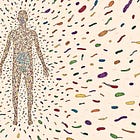Renewable Energy, Wind Turbines, and the Human Microbiome
Solar, wind, hydroelectric, and geothermal energy. Getting a healthy body with a healthy microbiome. AI in science.
Once a week, we write this email to share student-written work on science. Consider spreading the word to support us and win referral awards.
The Future of Renewable Energy: Innovations and Challenges
Solar Energy: Harnessing the Power of the Sun
Solar energy has seen remarkable advancements in recent years. Photovoltaic (PV) technology, which converts sunlight directly into electricity, has become more efficient and affordable. Innovations such as perovskite solar cells offer the promise of even greater efficiency and lower production costs compared to traditional silicon-based cells.
One of the most exciting developments in solar energy is the advent of solar power integration in urban environments. Building-integrated photovoltaics (BIPV) involve incorporating solar panels into building materials, such as windows and facades, transforming urban landscapes into energy-generating hubs. Transparent solar panels can be used in windows to generate electricity while still allowing light to pass through, seamlessly blending functionality with aesthetics.
Moreover, solar energy storage solutions have advanced significantly. Batteries, such as lithium-ion and emerging solid-state batteries, are crucial for storing solar energy for use when the sun is not shining. Coupled with smart grid technology, these storage systems enable more reliable and efficient energy distribution.
Wind Energy: Capturing Nature's Kinetic Power
Wind energy is another cornerstone of the renewable energy revolution. Advances in turbine technology have made wind power more efficient and cost-effective. Modern wind turbines are larger, with longer blades that can capture more wind and generate more electricity. Offshore wind farms, which take advantage of stronger and more consistent winds over the ocean, are also expanding rapidly.
One of the key challenges in wind energy is minimizing its environmental impact. Innovations such as bird-friendly turbine designs and improved siting strategies aim to reduce harm to wildlife. Additionally, efforts to recycle and repurpose old turbine blades are underway, addressing concerns about waste from decommissioned turbines.
Hydroelectric Power: Tapping into Water's Potential
Hydroelectric power has been a reliable source of renewable energy for decades. Traditional hydroelectric dams generate electricity by using the flow of water to spin turbines. However, large dams can have significant ecological and social impacts, including habitat disruption and displacement of communities.
To mitigate these issues, researchers are exploring new approaches to hydroelectric power. Small-scale hydropower systems, such as run-of-the-river installations, generate electricity without the need for large reservoirs, reducing environmental impact. Additionally, innovations in marine energy, including tidal and wave power, offer the potential to harness the energy of oceans and rivers in more sustainable ways.
Geothermal Energy: Unlocking the Heat Beneath Our Feet
Geothermal energy leverages the Earth's internal heat to generate electricity and provide heating and cooling. This reliable and constant energy source has significant potential, especially in regions with high geothermal activity. Enhanced geothermal systems (EGS) are a cutting-edge technology that involves creating artificial reservoirs by injecting water into hot rock formations, allowing geothermal energy to be harnessed in areas without natural reservoirs.
One of the primary challenges facing geothermal energy is the high upfront cost of drilling and development. However, advances in drilling technology and increased efficiency in EGS are making geothermal projects more viable. Furthermore, direct use applications, such as district heating systems and greenhouse heating, offer additional opportunities to utilize geothermal energy….
A Word From Our Sponsor: SciSpace
SciSpace is a next-gen AI platform for researchers where you can easily discover 280 million+ papers, conduct effortless literature reviews, chat with, understand, and summarize PDFs with its AI copilot, and so much more.
Try SciSpace. If you love it, get 40% off an annual subscription with code STEM40 or 20% off a monthly subscription with code STEM20.
Wind Power: A Growing Force in Renewable Energy
Wind power has emerged as a significant player in the global shift towards renewable energy sources. As countries worldwide seek to reduce their carbon footprint and combat climate change, wind energy offers a clean, sustainable alternative to fossil fuels. This article explores the current state of wind power technology, its benefits, challenges, and future prospects.
Wind turbines, the primary technology behind wind power, convert the kinetic energy of moving air into electrical energy. These structures, often arranged in large groups called wind farms, can be installed on land (onshore) or in bodies of water (offshore). Technological advancements have led to increasingly efficient and powerful turbines, with some modern offshore turbines capable of generating up to 14 megawatts of power - enough to supply thousands of homes with electricity.
The benefits of wind power are numerous. It is a clean energy source that produces no direct emissions, helping to reduce greenhouse gas emissions and combat air pollution. Wind is also a renewable resource, meaning it won't be depleted over time. Furthermore, wind farms can be built on existing farms or ranches, providing additional income for landowners without significantly impacting agricultural operations. Offshore wind farms, while more expensive to install, can harness stronger and more consistent winds without occupying valuable land.
Despite its advantages, wind power faces several challenges….
The Human Microbiome: A Microscopic Ecosystem
The human body is home to trillions of microscopic organisms, collectively known as the microbiome. This complex ecosystem of bacteria, viruses, and fungi plays a crucial role in human health and has become a focal point of modern medical research.
The microbiome is a diverse community of microorganisms that inhabit various parts of the human body, including the gut, skin, and respiratory tract. Microbial cells in the human body outnumber human cells by approximately 10 to 1. Each person's microbiome is distinct, influenced by factors such as diet, environment, and genetics. The gut microbiome communicates with the brain through the gut-brain axis, potentially influencing mood and behavior. A healthy microbiome aids in training and supporting the immune system. Certain gut bacteria produce essential vitamins and assist in digesting complex carbohydrates.
Research has linked the microbiome to various aspects of human health. Imbalances in gut bacteria have been associated with conditions like irritable bowel syndrome (IBS) and inflammatory bowel disease (IBD). Numerous studies suggest a potential link between the microbiome and conditions such as depression and anxiety. Gut bacteria composition may influence how the body processes food and stores fat. Early exposure to diverse microbes might play a role in preventing allergies and asthma. Ongoing research is exploring connections between certain gut bacteria and cancer risk.
Several strategies can support a balanced microbiome….
Last Week’s Most Popular Post
Quantum Chromodynamics: The Theory of Strong Interactions
A guide to the fundamentals of nuclear physics.
Quantum Chromodynamics (QCD) is the theory that describes the strong interaction, one of the four fundamental forces in nature. It is a part of the Standard Model of particle physics and explains how quarks and gluons interact to form protons, neutrons, and other hadrons. The journey of QCD began in the early 1970s when physicists sought to understand the strong force that binds quarks together....
The STEMScribe blog is a reader-supported publication. Subscribe to show your support. It’s free!
If you would like to submit a guest post to the blog, please fill out this form. If you enjoyed this post, consider spreading the word.
Issue #11






